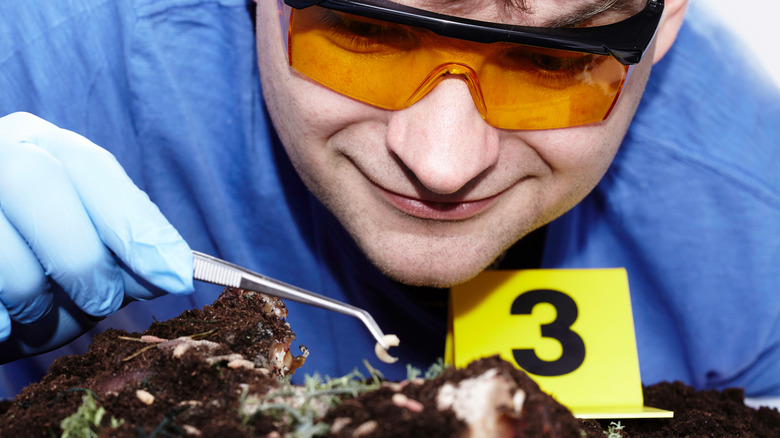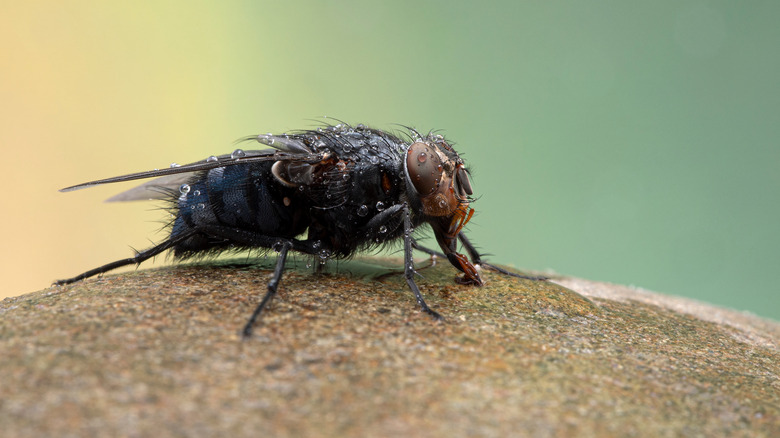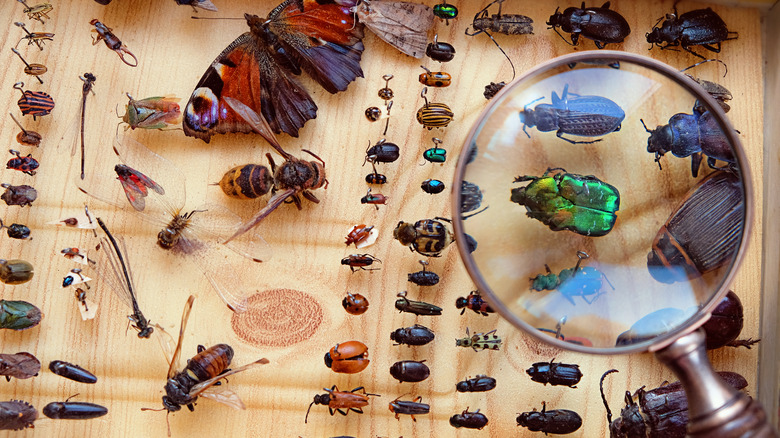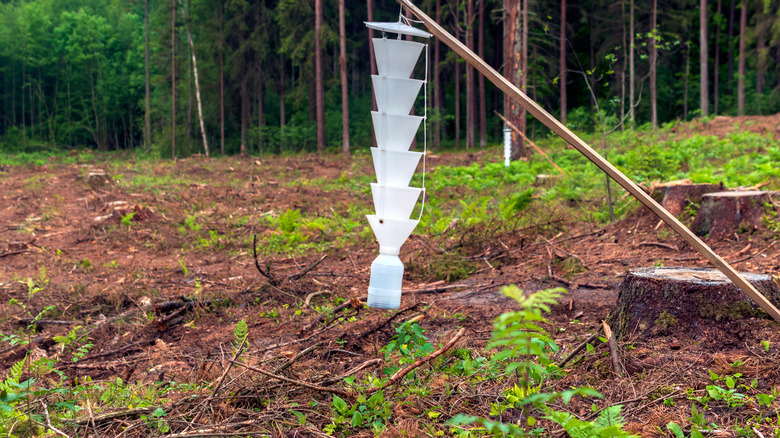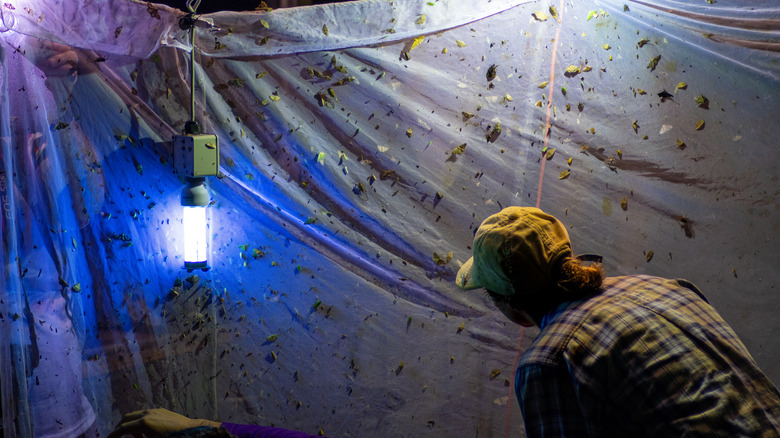The Science Behind The Creepy World Of Forensic Entomology
In 2002, a young woman named Kristin Blaise Lobato was convicted of murder and sexual penetration of a dead body. She was just 18 years old in 2001 when she was charged with the murder and mutilation of the body of a homeless man. In 2017, however, Lobato's conviction was overturned after she spent almost 16 years in prison for a crime that she didn't commit, per the Innocence Project. Thanks, in large part, to forensic entomology, Lobato's claims of innocence proved to be true.
Authorities use different means to solve cases, and oftentimes they turn to forensic entomologists to gather useful information that may help shed light on a case, or as mentioned, help free those who are innocent. Forensic entomology is the study of insects in criminal investigations, and it can help with determining the time of death, place of death, or even the cause of death (via National Library of Medicine). In Lobato's case, a forensic entomologist determined the man's time of death, and Lobato had an indisputable alibi, which meant she was wrongfully convicted.
The history of forensic entomology
Forensic entomology has been around for quite some time, and one of the first instances of entomology being used in a crime scene investigation was in 13th century China, as reported by Thought Co. Sung Ts'u was a lawyer and investigator who penned "The Washing Away of Wrongs," a book about criminal investigations. In one case, a farmer was murdered on a rice field with a sickle. However, it was difficult to determine the perpetrator, as most farmers owned sickles. Still, the farmers were ordered to lay down their sickles, and flies were attracted to one sickle that had microscopic blood and tissue residue. They found the murder weapon, and the killer confessed to the crime.
Although forensic entomology was used in early cases, it wasn't formally introduced in investigations until 1855. The first documented use of entomology in medicolegal was in the case of a mummified baby, according to Medscape. Insects on the body were studied, and the autopsy revealed that the baby died in 1848. Two years later, findings by a forensic entomologist were first used in a French court.
Branches of forensic entomology
Forensic entomology is broken down into three branches. The first is medicolegal forensic entomology, wherein insects that feed on dead organisms are studied in criminal cases. There is also a branch called urban forensic entomology, which entails the study of insects on structures — such as houses, hospitals, or schools — to determine the gravity of an infestation. The third branch is stored-product forensic entomology. Just as the name suggests, entomologists study the presence and growth of insects that infest stored goods in warehouses or packed products (via Entomology Today).
Forensic entomologists may be asked to provide statements in court during civil or criminal cases. Medicolegal forensic entomology is, perhaps, the most known branch among the three, but according to Crime Museum, experts can also be called in cases that involve food contamination, disputes between exterminators and homeowners, and toxicological studies, just to name a few.
Post-Mortem Interval
One of the most common uses of forensic entomology in criminal cases is determining how long a person has been dead or the Post-Mortem Interval (PMI). Entomologists study the insects that live on a cadaver in order to get the most accurate time of death. Samples are collected from the body — usually from orifices, wounds, or within the vicinity of the cadaver — and insect development is examined, as reported by the National Library of Medicine. The PMI is then calculated based on the life cycle of the insects collected.
However, there are also factors that can affect the accuracy of the PMI, such as the weather. For instance, a body left in hot weather conditions decomposes more quickly, and cold weather has the opposite effect, per the Crime Museum. The condition of the cadaver is studied as well to be able to come up with a more accurate result. Entomologists also follow a number of estimation protocols in determining the PMI, especially in cases where the time of death is crucial in a criminal investigation.
Body farms
There are several facilities in the U.S. dedicated to researching how corpses decompose in different conditions to have a better understanding of the process. These anthropological research facilities are called body farms, and they conduct research and training in forensic anthropology. According to A&E, many people choose to donate their bodies for scientific research, including health care professionals, service members, and police officers.
At the body farms, cadavers are left to decompose in different conditions outdoors, and entomologists study how insects contribute to the process. This allows them to work in a controlled environment and learn more information that may help in actual crime scenes, per The Atlantic. There is always something new to learn in the field, and with continued research, entomologists are able to have a better understanding of insect activity and can therefore present more accurate data in criminal cases.
Information gathered by entomologists
Apart from determining a person's time of death, forensic entomology can also be used to gather other crucial information in an investigation. One example is the drugs or toxins present in the body of the deceased. This can be done by examining the bodies, excrements, and shed exoskeletons of insects collected from the corpse, as reported by Explore Forensics. Additionally, DNA can be extracted from blood-sucking insects, which can determine whether a person was present at a crime scene.
By studying the development of insects, entomologists can also determine how long the body had been exposed to the elements before discovery, or whether the corpse was moved from one location to another (via Mental Floss). However, forensic entomology also has its limits, as each case is unique. Body farms and continued research are important because it offers fresh insights to entomologists that will aid in future cases.
